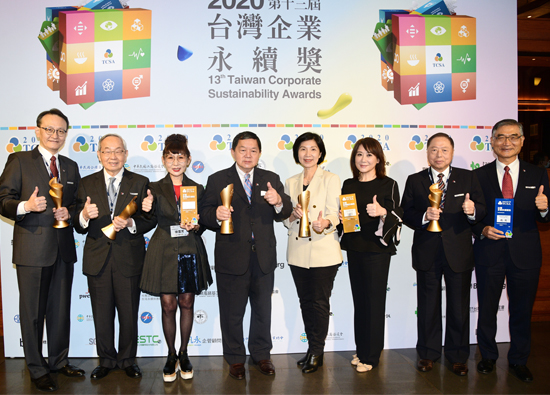01.2021 Cover Story
How to cope with the "Green Swan" threat due to climate change
Ernst & young United Certified Public Accountants / Zeng Yuzhe

.png)
In February 2020, a report in the economic daily "black swan, grey swan and green swan, the Central Bank teaches you a different biology lesson" has attracted attention in the field of sustainability. In addition to "black swan", the terms "grey swan" and "green swan" have been derived from financial markets in recent years to describe events that affect the overall situation of the global economy.
According to the explanation of the Central Bank in the Facebook, “black swan” describes the event that has a very low probability of occurring and is likely to be ignored. It has three characteristics, including uncertainty, great impact, and hindsight. The novel coronavirus pneumonia is an unprecedented “black swan” event. On the other hand, BIS released the "green swan" report in January 2020, warning that climate change may bring "green swan" event and trigger the global financial crisis.
"Green swan" is similar to "black swan", but it differs from "black swan" in that although the impact of climate change is highly uncertain, the risk of climate change is likely to be realized one day in the future; climate disaster is more serious than most systemic financial crisis, and may even pose a threat to human survival, causing complex and unpredictable chain reaction.
Anxiety about the urgency of climate change and global warming of capital market
At present, global investors pay close attention to ESG (environmental, social and Governance) issues. According to the 2020 Ernst & Young global investor survey report, 91% of investors have taken ESG performance as the evaluation index of investment decisions, According to the GSIA survey, 70% of investors consider the Task Force on Climate-related Financial Disclosures (TCFD) proposal into their investment and capital allocation decisions.
While the global novel coronavirus pneumonia epidemic continues to spread, investors are also highly concerned about the influence of environmental and climate impacts. It can be observed from the “global risk report 2020” that the impact degree of infectious diseases has been listed as one of the top ten risks, but the result of impact degree is quite different from that of likelihood. The top five risks of "likelihood" from high to low are: extreme weather events, failure to mitigate climate change, major natural disasters, loss of biodiversity and man-made environmental disasters. Climate risk events representing Green Swan may bring shock and impact to financial markets. In view of this, all sectors of society and financial authorities should continue to pay more attention to climate change to ensure the sustainable development of economic and living well-being.
The chief investment officer of NN Group, the biggest Holland life insurance group, Adrie Heinsbroek said that even if the novel coronavirus pneumonia causes short-term turbulence in the capital market, ESG's agenda will remain the fundamental basis for maintaining long-term resilience and sustainability development. Climate change and scarcity of water resource will ultimately be the key issue for the sustained recovery of the economy in the future. The chief of pension impact of Australian HESTA Group, Adrie Heinsbroek said that the novel coronavirus pneumonia is attracting the current social concern, but the predicament faced by HESTA shows that the organization's ability to cope with the major risks is still insufficient. The "s" in ESG can be said to be the core. Enterprises must think about how to build their resilience to social and environmental risks.
The attention paid by capital markets of various countries to the climate changes
International disclosure requirements for climate change related information are becoming more stringent with investors' expectations. The government may as well refer to the trend of international development and set corresponding disclosure and management policies for climate change information from different aspects such as corporate governance, financial industry characteristics, environment and society.
The Securities and Futures Commission of Hong Kong (SFC) announced the strategic framework for green finance development in September 2018 to enhance the comparability and consistency of listed companies' disclosure of relevant environmental information. The five strategies in the framework mentioned the necessity of integrating with TCFD. First, the disclosure of environmental information of listed companies should be strengthened, especially the disclosure of climate related information. Keep paying attention to the policy of mandatory environmental information disclosure in the mainland in 2020, and aim to achieve the goal of integrating with TCFD disclosure recommendations.
In 2017, the European Commission's financial and capital markets alliance published the non-financial reporting directive, which requires enterprises with more than 500 employees to disclose environmental and climate information. In the revised version in 2019, the content combined with TCFD was added.
The Department for Business, Energy and Industrial Strategy, BEIS of the UK also issued the green finance strategy in 2019, which proposed that the government hopes to require all listed companies and large companies to disclose in accordance with TCFD and improve the transparency of disclosure before 2022. The government will put forward the interim report at the end of 2020 as a proposal to introduce TCFD. The Financial Conduct Authority, FCA of the UK expects that in 2022, listed companies will be required to disclose climate related information in accordance with the TCFD framework, and a consultation document will be issued in 2020 to integrate the practical suggestions of various stakeholders on the implementation of TCFD.
In Japan, the second basic measure in the "2020 climate innovation financing strategy" issued by the Ministry of Economy, Trade and Industry of Japan in September 2020 is "enterprises should take the initiative to disclose corporate information with TCFD". As for how enterprises should adopt the TCFD framework, the Ministry of Economy, Trade and Industry launched the first TCFD Guide (TCFD ガイダンス) in 2018, and launched TCFD guide 2.0 in July 2020 in cooperation with the private TCFD Consortium. These reports are not mandatory guidelines, and TCFD guide 2.0 not only introduces the latest international implementation of TCFD and Japanese benchmark cases, but also provides strategies for nine industries facing different risks and opportunities to cope with climate change.
The significance of green finance 2.0 plan in climate action
The Financial Supervision Commission (FSC) issued the "green finance plan 2.0" in 2020, which aims to guide enterprises and investors to pay attention to ESG issues through the financial mechanism, promote a virtuous cycle of investment and industry pursuing sustainable development, and achieve carbon reduction and sustainable development through public-private partnership. The significance lies in that sustainability development is the core value that the world attaches importance to at present, and financial institutions gather public funds for management and investment, which not only has a large scale of assets, but also plays the role of allocating social resources, which is the key force to guide the whole society to attach importance to sustainability development. International financial market forces are used to promote sustainability development, from the early focus on green or environmental aspects of green finance to sustainable finance covering ESG, which has become the core of financial policy development.
Financial Supervisory Commission took into account international practices, suggestions from relevant ministries, experts, scholars and non-profit organizations, as well as the promotion experience of the practitioners, the green finance action plan 2.0 was proposed to plan the short-term and medium-term promotion priorities, and to establish a framework and foundation for promoting the effective operation of green and sustainable financial markets by means of annual rolling revision, including improving the quality and transparency of ESG information disclosure, establish the definition or classification standard of green and sustainable development industry, so as to guide financial institutions to gradually expand from investment and financing of green energy industry to support green and sustainability development, and cultivate the resilience of financial institutions to cope with climate change risks.
In addition to setting short-term and medium-term goals, the green finance action plan 2.0 has three core strategies and eight driving directions, with a total of 38 specific measures (17 of which are the continuous processing plan 1.0 and 21 of which are the new plan 2.0). The main contents are as follows:
1. Short term: establish a framework and foundation to promote the effective operation of green and sustainable financial markets, enhance information transparency to guide funds to support green and sustainable development industries.
2. Medium term: guide the financial market to cope with the potential risks and business opportunities of climate change, strengthen the competitiveness of financial industry and financial market, and guide enterprises and investors to pay attention to ESG issues through the financial mechanism, so as to promote a virtuous circle of green and sustainable development for investment and industry.
Green finance refers to the financial investment in sustainability development or environmental protection industry, including investment in green products and enterprises supporting sustainability development, so as to adjust the allocation of financial resources and achieve the sustainability development of environment, society and economy.
The traditional financial system is also faced with many challenges. It needs the government to modify the existing financial, regulatory and economic development environment restrictions with a more forward-looking thinking, so as to meet the international determination to fight climate change and the national greenhouse gas reduction target. From the supply side of green finance, the way for financial institutions to respond may be to continuously develop innovative green financial products, enhance the ability of medium and long-term capital investment, support the development of energy conservation and environmental protection industry, promote economic restructuring with green finance, and attract international investors to pay attention to Taiwan bonds. From the demand side, enterprises will be able to solve the problem of capital gap and mismatch, attract domestic and foreign green investors, enhance their brand influence, implement green and renewable energy projects, respond to greenhouse gas reduction policies and undertake social responsibility.
However, the promotion of green finance and sustainable finance involves a wide range of levels and professional fields. In addition to the joint implementation of the Financial Supervisory Commission through inter-ministerial meetings, it will also be promoted by combining the strength of relevant financial associations, peripheral units and businesses.
The next step of identifying climate related financial data
Ernst & Young has been assisting all walks of life in Taiwan to promote TCFD. Yu Zhe, certified accountant of climate change and sustainability development services of Ernst & young, was also the chief editor of TCFD, he was responsible for the translation of TCFD (Chinese traditional version), hoping to deepen the understanding and application of Chinese people and enterprises and promote a sustainable financial and governance environment.
Taking a comprehensive view of corporate governance 3.0, green finance 2.0 and the quality and transparency of ESG information disclosure, it is required that the policies should be geared to the future. In accordance with the standards issued by TCFD and SASB, it summarizes the specific actions of various sectors in Taiwan on climate related risks, including:
Government: promote green and sustainable standards in Taiwan, establish sustainable financial standards, and continue to issue guidelines.
Financial institutions: assist the development of green and sustainable industries, and make more extensive use of ESG tools.
Non-profit organizations: strengthen communication between stakeholders in Taiwan and green and sustainable issues.
The "Green Swan" of the Bank for International Settlements has put forward some systematic methods. If it is necessary to effectively identify climate related financial risks, it needs to consider in sequence: climate policy and energy policy analysis, macroeconomic analysis, or combined with industrial greenhouse gas emission analysis, exposure range analysis, credit risk and market risk analysis.
Due to the lack of analysis data on the impact of climate policy and energy policy on the overall economy in Taiwan, how to effectively identify climate related financial risks for enterprises and financial industry in the future depends on systematic, cross platform and cross field professional cooperation. The challenges and difficulties that will be encountered include: financial instability caused by climate risk, demand for new technology and professionals, lack of climate change risk assessment expertise, lack of cross unit task force to deal with macro climate risk.
Ernst & Young suggests that when analyzing the impact of climate policy and energy policy on the overall economy, more climate finance forums and conferences should be held to create successful cases and continuously refer to the international situation; at the same time, a multilateral communication platform should be established to formulate TCFD promotion policies in line with the situation of Taiwan, and introduce, develop and popularize various ESG tools.
Climate change is full of uncertainty, and its impact is more long-term and complex than the known risks in the past. Once it happens, it will have a huge impact. Therefore, TCFD requires enterprises to evaluate the possible impact of climate risk and reflect it on the financial statements of enterprises. The company needs to understand the scale and time of the enterprise affected by climate change, and involves technician, compliance personnel, investors' concerns, etc. Therefore, through cross departmental cooperation, communication and evaluation, which includes the collaboration of financial, planning, business, management, environmental safety and health, investment relations and other departments, TCFD will be introduced into the company, and assist managers and investors in making the best decisions with the purpose of disclosing company's statutory financial declaration documents.



















